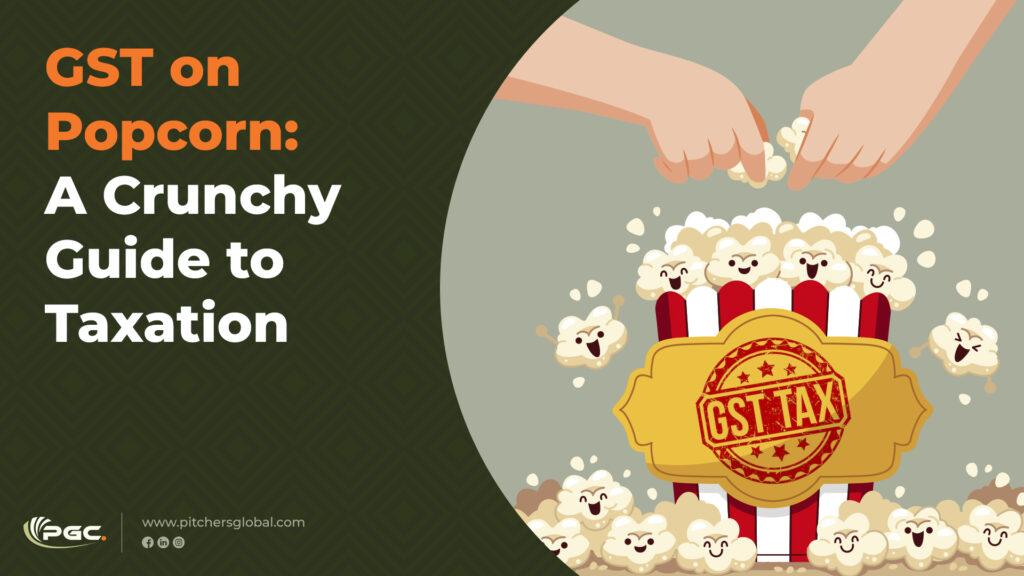Popcorn is an all-time favorite snack for movie-goers. However, in India, the taxation of popcorn under the Goods and Services Tax (GST) system has evolved over time, leading to different tax rates based on its form, preparation, and packaging. Let’s dive into the details to better understand how GST applies to popcorn and what it means for both vendors and consumers.

Popcorn Taxation Before the 55th GST Council Meeting
Before the 55th GST Council meeting, popcorn taxation was simpler but not without ambiguities. Both loose popcorn sold at theatres and pre-packaged popcorn were taxed at a flat 5% GST rate. This rate aligned with the treatment of other non-luxury food items that were not pre-packaged. Whether salted or spiced, loose popcorn was classified as a basic snack and taxed accordingly.
Key Changes Introduced by the 55th GST Council Meeting
The 55th GST Council meeting brought significant changes to how popcorn is taxed, introducing distinctions based on packaging, labeling, and added ingredients. Here’s a breakdown of the revised structure:
- Loose Popcorn (Unpackaged): The GST rate remained at 5%. This category includes freshly served popcorn at theatres, classified as a basic snack under the ‘namkeen’ category.
- Pre-Packaged and Labeled Popcorn: This type of popcorn, previously taxed at 5%, now attracts a 12% GST rate. The change reflects the higher costs and convenience associated with packaged food products.
- Caramelized Popcorn: With added sugar, caramel popcorn saw a significant tax increase to 18%, categorized as a sugar confectionery under HS Code 1704 90 90, similar to chocolates and candies.
Current GST Classification
The GST Council has classified popcorn into three categories, each with its own tax rate:
- Loose Popcorn (Unpackaged and Unlabelled): Taxed at 5%, consistent with other ‘namkeen’ snacks.
- Pre-Packaged and Labeled Popcorn: Attracts a 12% GST rate, categorized alongside other packaged food items.
- Caramelized Popcorn: Taxed at 18% due to its sugar content, making it a confectionery product.
Why Do Different GST Rates Apply to Popcorn?
The GST system differentiates popcorn based on its preparation, ingredients, and packaging:
- Loose Popcorn: Retains the characteristics of namkeens, justifying the lower 5% tax rate.
- Pre-Packaged Popcorn: The additional cost of packaging and labeling warrants a higher 12% GST.
- Caramel Popcorn: The presence of added sugar makes it a confectionery item, subject to the highest tax rate of 18%.
GST on Popcorn Bundled with Movie Tickets
Popcorn sold as part of a combo with movie tickets brings additional complexity. In such cases, the GST rate for the entire bundle is determined by the ticket’s tax rate:
- If the movie ticket is taxed at 12%, the bundled popcorn also attracts 12% GST.
- If the movie ticket is taxed at 18%, the entire combo is taxed at 18%, regardless of the popcorn’s standalone classification.
This approach can make bundled popcorn more expensive than buying it separately.
Impact on Vendors and Consumers
For Vendors:
Managing the varying GST rates introduces administrative challenges. Vendors must carefully categorize and price popcorn based on its type—whether loose, pre-packaged, or caramelized—to comply with GST regulations.
For Consumers:
The impact of GST depends on the type of popcorn they choose:
- Loose popcorn: Remains budget-friendly at a 5% GST rate.
- Pre-packaged popcorn: Costs more due to the 12% GST rate.
- Caramelized popcorn: The most expensive option, taxed at 18%.
- Bundled popcorn with tickets: Pricing varies based on the movie ticket’s GST rate, adding unpredictability.
GST System Comparisons
The complexity of GST classifications for popcorn is not unique. Similar issues exist for other products like coconut oil, which is taxed differently depending on whether it is used for cooking (5%) or personal care (18%). These distinctions highlight the intricacies of India’s tax system and the importance of clear classifications.
To streamline these classifications, the GST Council uses the Harmonized System Code (HS Code), ensuring consistency across various industries. For popcorn, this system helps tax different types correctly based on their characteristics.
Conclusion
The GST rates for popcorn reflect the diverse ways in which this snack is prepared, packaged, and sold. While loose popcorn remains affordable with a 5% tax, pre-packaged and caramelized options carry higher rates, impacting pricing for consumers. For vendors, the challenge lies in maintaining compliance and accurate pricing for various popcorn types.
Follow Pitchers Global for More!
